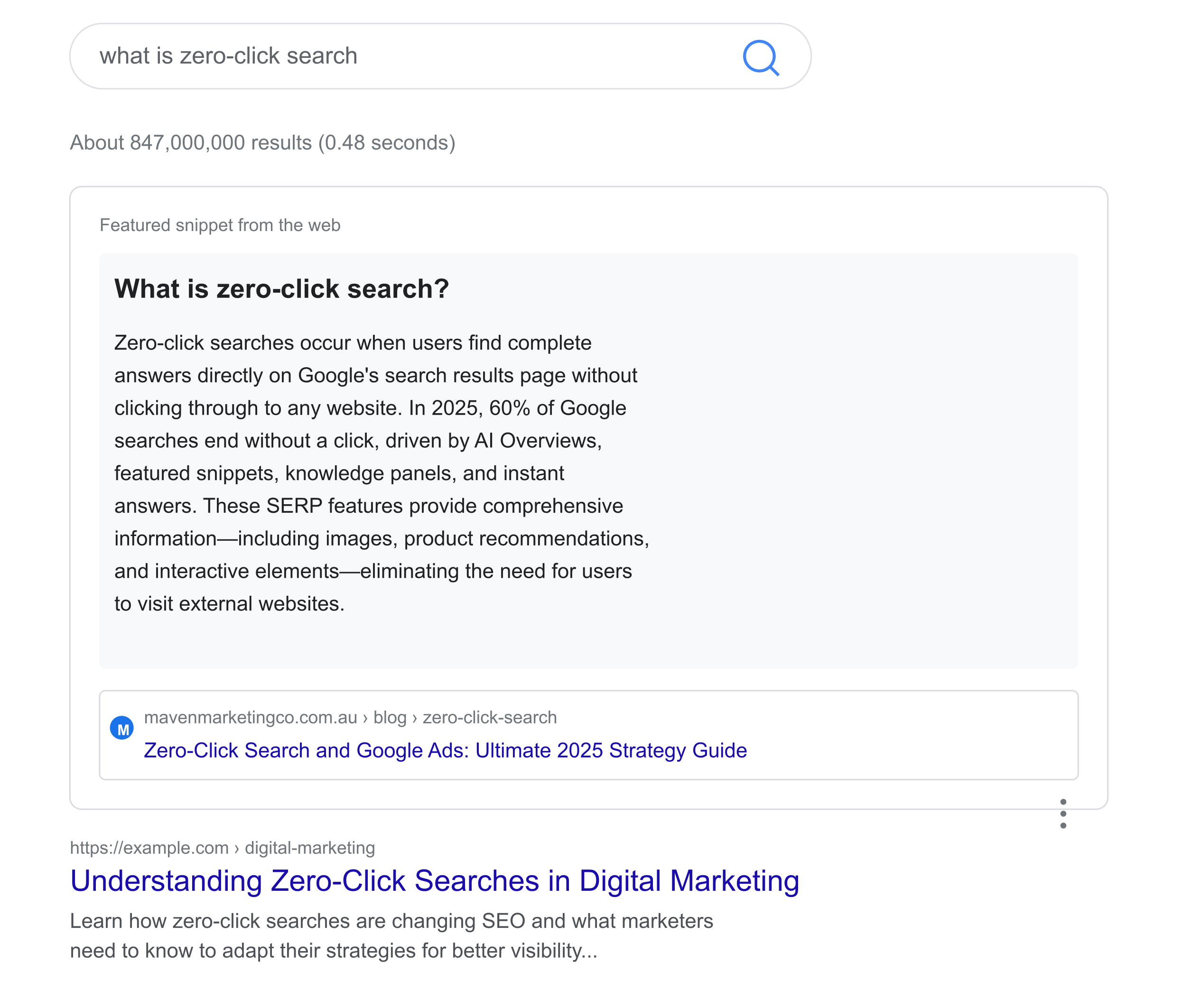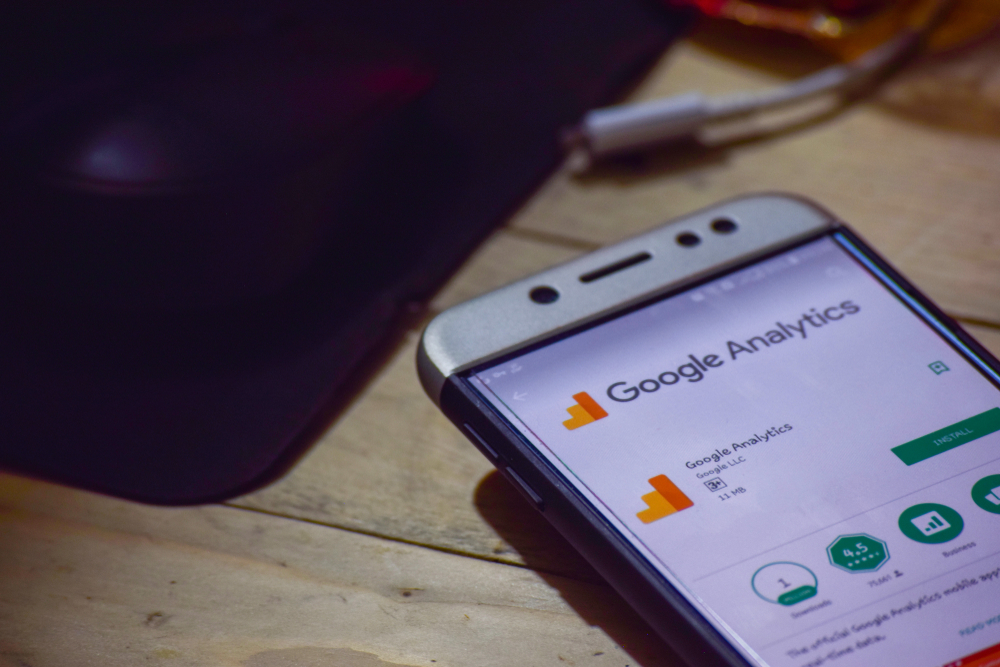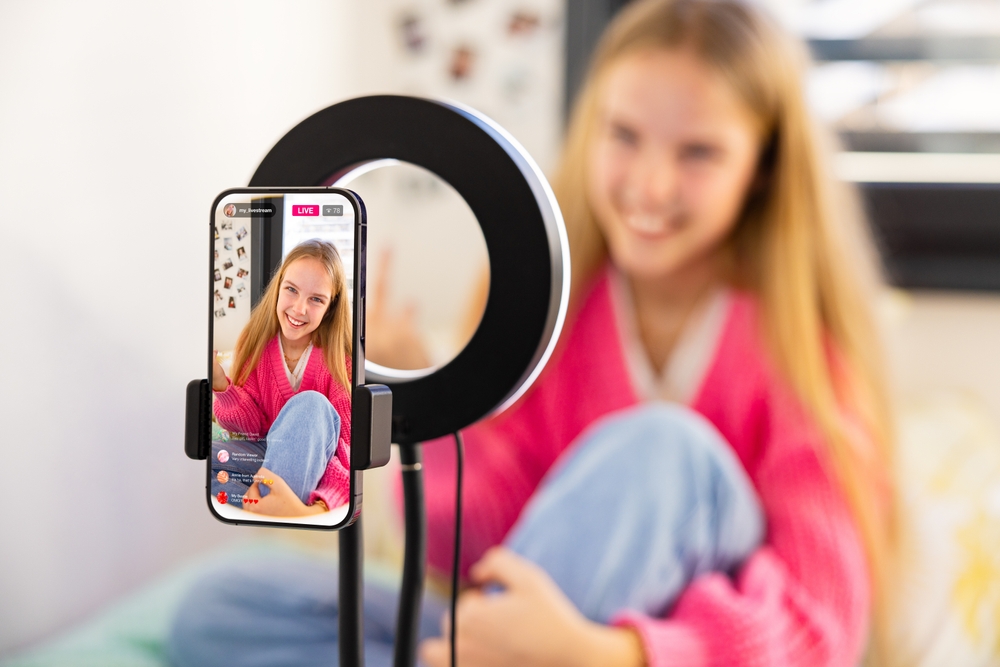
The rules of search have fundamentally changed. If you're still running Google Ads campaigns the same way you did in 2023, you're haemorrhaging money and missing opportunities. The emergence of zero-click search behaviour—where users get their answers directly on Google's search results page without visiting any website—has created a new battleground for digital marketers.
In 2025, 60% of Google searches end without a click, and the trend shows no signs of slowing. In March 2025, 27.2% of US searches ended without a click compared to 24.4% in March 2024. Meanwhile, organic click-through rates dropped to 40.3% in the US, leaving businesses scrambling to maintain visibility and conversions.
For Australian businesses investing in Google Ads, understanding this shift isn't optional—it's survival. This comprehensive guide will show you exactly how zero-click search impacts your PPC performance and, more importantly, how to adapt your strategy to thrive in this new environment.
Understanding the Zero-Click Search Phenomenon
Zero-click searches occur when users find complete answers directly on Google's search results page (SERP) without clicking through to any website. This isn't entirely new—featured snippets, knowledge panels, and instant answers have existed for years. What's different in 2025 is the scale and sophistication driven by artificial intelligence.
The AI Acceleration Factor
Google's AI Overviews (formerly Search Generative Experience or SGE) have fundamentally transformed search results. The share of queries triggering AI Overviews jumped from 6.49% in January 2025 to 13.14% in March 2025, and this growth trajectory suggests we'll see AI-generated summaries dominating search results by year's end.
These aren't simple answer boxes. AI Overviews synthesise information from multiple sources into comprehensive, multi-paragraph responses complete with images, product recommendations, and interactive elements—all without requiring users to leave Google.

The Mobile Amplification Effect
On mobile devices, over 75% of searches resulted in zero-click outcomes in 2024, making the challenge even more acute for businesses targeting mobile users. With screen real estate at a premium, AI Overviews and featured snippets dominate mobile SERPs, pushing traditional organic listings—and paid ads—further down the page.
SERP Features Driving Zero-Click Behaviour
Several SERP elements contribute to the zero-click phenomenon:
Featured Snippets: Concise answers extracted from web pages and displayed prominently at the top of results. Featured snippets in the first position get an impressive 42.9% click-through rate, beating the standard first organic result's 39.8% CTR. This proves that whilst snippets can reduce clicks, they can also increase traffic when users want more detail.

Knowledge Panels: Information boxes on the right side of desktop results (or top of mobile) pulling data from authoritative sources like Wikipedia, providing instant facts about entities, businesses, and topics.
People Also Ask (PAA): Expandable question boxes that answer related queries without requiring clicks to external sites.
Local Packs: Map-based results showing business locations, contact information, reviews, and hours—everything a user needs without visiting the actual business website.
AI Overviews: Google's Gemini model creates these detailed responses by combining information from multiple sources, taking up 1,345 pixels when expanded and 403 pixels when collapsed, pushing the first organic result down to 1,686 pixels.
Calculators, Converters, and Instant Answers: Built-in tools that handle simple queries like unit conversions, calculations, weather forecasts, and definitions directly on the SERP.
The Impact on Traditional SEO and Organic Traffic
For businesses that invested heavily in SEO, the zero-click trend represents a fundamental challenge. You can rank #1 for valuable keywords and still watch your traffic decline as users get their answers from featured snippets or AI Overviews that summarise your content without sending clicks.
Publishers and content creators face the most severe impact. News sites, in particular, have been devastated—industry reports indicate that traffic from news-related searches has declined dramatically as AI Overviews provide comprehensive summaries of breaking stories.
For Australian businesses, this means your carefully crafted content strategy might deliver brand visibility and authority but generate fewer website visits, form submissions, and direct conversions than historical performance would suggest.

Why Zero-Click Search Makes Google Ads More Important Than Ever
Here's the counterintuitive reality: as organic visibility and clicks decline, Google Ads becomes more valuable, not less. Let me explain why.
Paid Ads Maintain Prominent Positioning
Whilst AI Overviews and featured snippets push organic results down the page, paid ads still appear at the very top of search results. When users do decide to click, your Google Ads have prime positioning to capture that click before any organic result.

Higher-Quality Traffic and Conversions
When someone clicks a paid ad in a zero-click environment, they're demonstrating stronger intent. They've seen the AI Overview or featured snippet, determined they need more than the surface-level answer, and actively chosen to engage with a business. This translates to better conversion rates.
Research consistently shows that paid search visits are 35% more likely to convert compared to organic search—a conversion advantage that becomes even more pronounced in the zero-click era.
Controlled Visibility Regardless of SERP Changes
With organic rankings, you're at Google's mercy. With paid ads, you control your presence. Budget allocation, bid strategy, and ad creative give you levers to maintain visibility even as SERP layouts shift and AI features expand.
Capturing Lost Organic Opportunity
As competitors watch their organic traffic decline without adjusting strategy, smart advertisers can capture that abandoned audience through targeted Google Ads campaigns. The users are still searching—they're just not clicking organic results the way they used to.
Strategic Google Ads Adjustments for the Zero-Click Era
Success in 2025 requires rethinking traditional PPC approaches. Here are the specific strategic shifts Australian businesses must make:
1. Prioritise Commercial and Transactional Keywords
Not all keywords are equally affected by zero-click behaviour. Informational queries (how-to, what is, why does) are most susceptible to zero-click outcomes because AI Overviews and featured snippets easily answer these questions.
Commercial and transactional keywords—where users are ready to purchase, book, or engage—maintain stronger click-through rates because AI Overviews can't complete transactions. Users must visit websites to take action.

Strategic shift: Allocate more budget toward bottom-of-funnel keywords with clear commercial intent. Terms like "buy," "price," "near me," "best deals," and service-specific phrases should dominate your keyword portfolio.
Australian context: Geo-specific commercial terms ("plumber Sydney CBD," "digital marketing agency Melbourne," "buy furniture Brisbane") remain high-value because they signal immediate intent and local AI results still drive clicks to local businesses.
2. Leverage Performance Max for AI Overview Placements
With AI Overview ads live and AI Mode ads starting to leak out, these placements will eventually be part of the Performance Max portfolio. Performance Max campaigns use Google's machine learning to automatically place ads across all Google properties—Search, Display, YouTube, Gmail, Discovery, and Maps.
In the context of AI Overviews, Performance Max will likely gain placement opportunities within or adjacent to AI-generated results, putting your ads directly in the highest-visibility SERP real estate.
Strategic approach:
- Build robust Performance Max campaigns with high-quality creative assets
- Implement enhanced conversion tracking to feed Google's algorithms accurate data
- Provide comprehensive audience signals to guide machine learning
- Monitor placement reports to understand where your ads appear and perform best
Critical caveat: Performance Max requires strong conversion tracking and significant budget to perform optimally. For smaller businesses or those with limited conversion data, maintain traditional Search campaigns alongside Performance Max rather than shifting entirely.
3. Expand Beyond Search Campaigns
Users are visiting additional platforms more often such as Reddit or TikTok, and zero-click searches are causing previously top-ranked businesses to sink to lower search ranking positions. This creates an imperative to diversify your paid media strategy across multiple Google Ads campaign types:
Shopping Campaigns: Product listings with images, prices, and details appear prominently in search results, particularly for e-commerce queries. Shopping ads provide the detailed information users need directly in the SERP, functioning as a "premium" zero-click experience that still drives clicks and conversions.
YouTube Ads: YouTube is now the top destination for traditional search in the US, EU, and UK. Users increasingly turn to YouTube to find how-to content, product reviews, and educational material. Video ads on YouTube capture attention that's shifting away from traditional search results.
Display and Discovery Campaigns: Reach users across Google's vast network of partner websites and apps, maintaining brand visibility beyond search results pages.
Local Services Ads: For service-based businesses, Local Services Ads appear at the absolute top of local search results, above even traditional paid search ads, with Google-guaranteed badges that build trust.
4. Optimise Ad Copy for Post-Zero-Click Context
Users who click your ads after viewing AI Overviews or featured snippets have already consumed basic information. Your ad copy must offer something beyond what they've already seen:
Compelling offers: Time-sensitive discounts, exclusive deals, or unique value propositions that AI summaries can't provide.
Specific solutions: Address pain points or specific use cases that generic AI responses can't fully solve.
Trust signals: Incorporate reviews, ratings, awards, or credentials directly in ad copy to differentiate from competitors.
Strong calls-to-action: Use action-oriented language that creates urgency: "Book Today," "Limited Availability," "Free Consultation," "Get Custom Quote."
5. Implement Smart Bidding with Conversion Focus
Manual bidding strategies are increasingly obsolete in the AI-driven advertising landscape. Google's Smart Bidding algorithms analyse billions of signals in real-time to optimise bids for your specific goals.
Recommended strategies:
- Target ROAS (Return on Ad Spend): When you have sufficient conversion value data
- Maximise Conversions: When driving volume is the priority within budget constraints
- Target CPA (Cost Per Acquisition): When you have a specific cost-per-conversion target
Critical requirement: Smart Bidding requires robust conversion tracking. Implement enhanced conversions, import offline conversion data, and use Google Analytics 4 integration to provide the algorithm with comprehensive performance signals.
6. Embrace First-Party Data and Audience Targeting
As zero-click search changes user behaviour and third-party cookies disappear, first-party data becomes your competitive advantage. Building and leveraging your own customer data allows for precise audience targeting regardless of SERP changes.
Tactics for Australian businesses:
- Customer Match: Upload email lists of existing customers to target them directly or create similar audiences
- Website visitor remarketing: Re-engage users who visited your site but didn't convert
- Customer lifecycle targeting: Create separate campaigns for new customer acquisition vs. existing customer retention
- Lookalike audiences: Let Google find users similar to your best customers

7. Focus on Brand Visibility Metrics Beyond Clicks
Traditional PPC metrics—clicks, click-through rate, cost-per-click—remain important but don't tell the complete story in a zero-click world. Expand your measurement framework to capture broader impact:
Brand search volume: Track increases in branded search queries, indicating growing awareness even if users don't always click
Impression share: Monitor how often your ads appear for target keywords relative to total available impressions
Top-of-page rate: Measure how frequently your ads secure premium positions
View-through conversions: Track conversions from users who saw but didn't click your ads, then later converted
Assisted conversions: Understand how your ads contribute to conversion paths even when they're not the final click
Share of voice: Analyse your brand's presence in search results compared to competitors
These metrics help justify continued ad spend even when direct click volume might decline, demonstrating the broader brand-building value of your Google Ads investment.
8. Optimise Landing Pages for Higher Intent Traffic
Remember: users who click through after viewing AI Overviews or featured snippets have already consumed basic information. Your landing pages must provide immediate, advanced value:
Fast load times: Users won't wait. Optimise for sub-two-second load times on mobile devices.
Clear value proposition: Immediately communicate what makes your offer unique or better than what they saw in the AI Overview.
Simplified conversion paths: Reduce form fields, offer guest checkout, enable digital wallet payments, and eliminate friction.
Social proof: Display reviews, testimonials, case studies, and trust badges prominently.
Personalisation: Use dynamic content that adapts based on the user's search query, location, or previous interactions.
Industry-Specific Considerations for Australian Businesses
Different industries face varying degrees of zero-click impact. Here's how to adapt based on your business type:
E-commerce and Retail
Shopping campaigns become critical as product-focused searches increasingly show Shopping results that provide detailed product information directly in SERPs. Ensure your product feed is optimised with high-quality images, accurate pricing, comprehensive attributes, and competitive shipping information.
Leverage Google Merchant Center promotions to differentiate your products with special offers that appear directly in Shopping ads. Implement Performance Max for Shopping to automatically showcase products across Google's entire ecosystem.
Local Service Businesses (Plumbers, Electricians, Lawyers, etc.)
Local Services Ads provide maximum visibility above all other results with Google-guaranteed trust badges. For service businesses, this placement is invaluable as local searches maintain relatively strong click-through rates.
Optimise your Google Business Profile meticulously—it appears in Local Pack results and provides comprehensive business information without clicks. Encourage and respond to reviews, upload photos regularly, and keep business hours and contact information current.
Use location extensions and call extensions aggressively in Search campaigns to make it effortless for mobile users to contact you directly from the ad.
B2B and Professional Services
B2B searches show strong resistance to zero-click behaviour for complex services. Decision-makers researching enterprise solutions, professional services, or sophisticated technology need more than AI summaries can provide.
Focus on educational content and thought leadership in your ad strategy. Use responsive search ads highlighting specific expertise, case studies, and industry credentials. Target long-tail, specific queries that indicate research-phase buyers rather than broad informational terms.
Healthcare and Medical Services
Healthcare searches are heavily regulated and often require personal interaction. Whilst AI Overviews might answer general health questions, appointment booking, specialist consultations, and treatment decisions require website visits.
Prioritise conversion-focused campaigns targeting treatment-specific and condition-specific keywords. Use ad extensions to display phone numbers, location information, and online booking options prominently.
Hospitality and Tourism
Visual search and discovery are critical for hospitality businesses. YouTube ads showcasing property videos, Discovery campaigns featuring stunning imagery, and Shopping ads for travel packages capture attention across Google's visual platforms.
User-generated content in ads (customer photos, reviews, testimonials) builds trust and differentiates your offering from AI-generated travel summaries.
Measuring Success in the Zero-Click Era: New KPIs That Matter
Traditional PPC reporting focused heavily on clicks, conversions, and return on ad spend. These metrics remain important, but incomplete. Here's how to build a more comprehensive measurement framework:
Attribution Modelling
Move beyond last-click attribution to data-driven or position-based models that recognise the full customer journey. Google Ads attribution reports show how different touchpoints contribute to conversions, even when your ad isn't the final click.
Incremental Lift Testing
Run controlled experiments comparing performance in geographies or audience segments with and without specific campaign activities. This reveals the true incremental impact of your advertising beyond direct response metrics.
Brand Lift Studies
Google offers brand lift surveys that measure changes in brand awareness, consideration, and purchase intent among users exposed to your ads versus control groups. This quantifies the branding value of your campaigns separate from direct conversions.
Multi-Touch Campaign Analysis
Use Google Analytics 4 to analyse the complete path to conversion, understanding how paid search interacts with organic search, direct traffic, social media, and other channels. This holistic view prevents undervaluing paid search's contribution to overall business outcomes.

Common Mistakes to Avoid in 2025 Google Ads
As businesses adapt to zero-click dynamics, certain pitfalls consistently undermine performance:
Over-reliance on broad match keywords: In a zero-click environment, precision matters more than ever. Broad match can waste budget on informational queries destined for zero-click outcomes.
Ignoring negative keywords: Continuously expand negative keyword lists to exclude queries where AI Overviews or featured snippets satisfy user intent completely.
Neglecting mobile optimisation: With mobile zero-click rates exceeding 75%, ensuring your ads and landing pages deliver exceptional mobile experiences is non-negotiable.
Abandoning organic SEO: While this article focuses on paid strategy, don't give up on SEO. Strong organic presence feeds data for remarketing audiences, builds brand authority that improves paid performance, and can earn you placement in AI Overview citations.
Setting unrealistic expectations: Click-through rates across industries are declining. Adjust benchmarks and communicate these realities to stakeholders to avoid panic over "declining performance" that's actually industry-wide shifts.
The Future: What's Coming in Late 2025 and Beyond
Based on current trajectories, expect these developments:
Increased AI Overview prevalence: Projections suggest over 70% of searches could result in zero clicks by end of 2025. Plan accordingly.
AI Mode expansion: Google's fully conversational AI search interface will likely roll out more broadly, fundamentally changing how users interact with search.
Ad placements within AI results: As AI Overviews become more common, expect Google to monetise them through integrated ad placements, creating new premium inventory.
Enhanced first-party data capabilities: Google will continue developing tools that help advertisers leverage their own customer data as third-party alternatives disappear.
Cross-platform integration: Google will increasingly unify advertising across Search, YouTube, Maps, Shopping, and Chrome browser, requiring more holistic multi-channel strategies.
Conclusion: Thriving in the Zero-Click Era
Zero-click search represents the most significant shift in digital advertising since mobile-first indexing. With 60% of searches ending without clicks and AI Overviews expanding rapidly, traditional approaches to Google Ads are becoming obsolete.
But this isn't a crisis—it's an evolution. The businesses that adapt their strategies to prioritise commercial keywords, leverage AI-powered campaign types like Performance Max, diversify across Google's advertising ecosystem, optimise for higher-intent traffic, and measure success through expanded KPIs won't just survive—they'll capture market share from competitors still running 2023 playbooks in a 2025 environment.
The zero-click era doesn't diminish Google Ads' value; it increases it. As organic visibility declines and users become more selective about which results they click, paid advertising offers the controlled, measurable, scalable visibility that separates market leaders from everyone else.
The choice is yours: adapt and thrive, or maintain the status quo and watch your digital advertising ROI erode month after month. Maven Marketing stands ready to help you choose growth.
Contact us today at mavenmarketingco.com.au and let's build your zero-click-proof Google Ads strategy together.
Maven Marketing is an Australian digital marketing agency specialising in Google Ads management and PPC strategy. We help businesses across Sydney, Melbourne, Brisbane, Perth, and beyond maximise their advertising ROI through data-driven campaigns and continuous optimisation.









